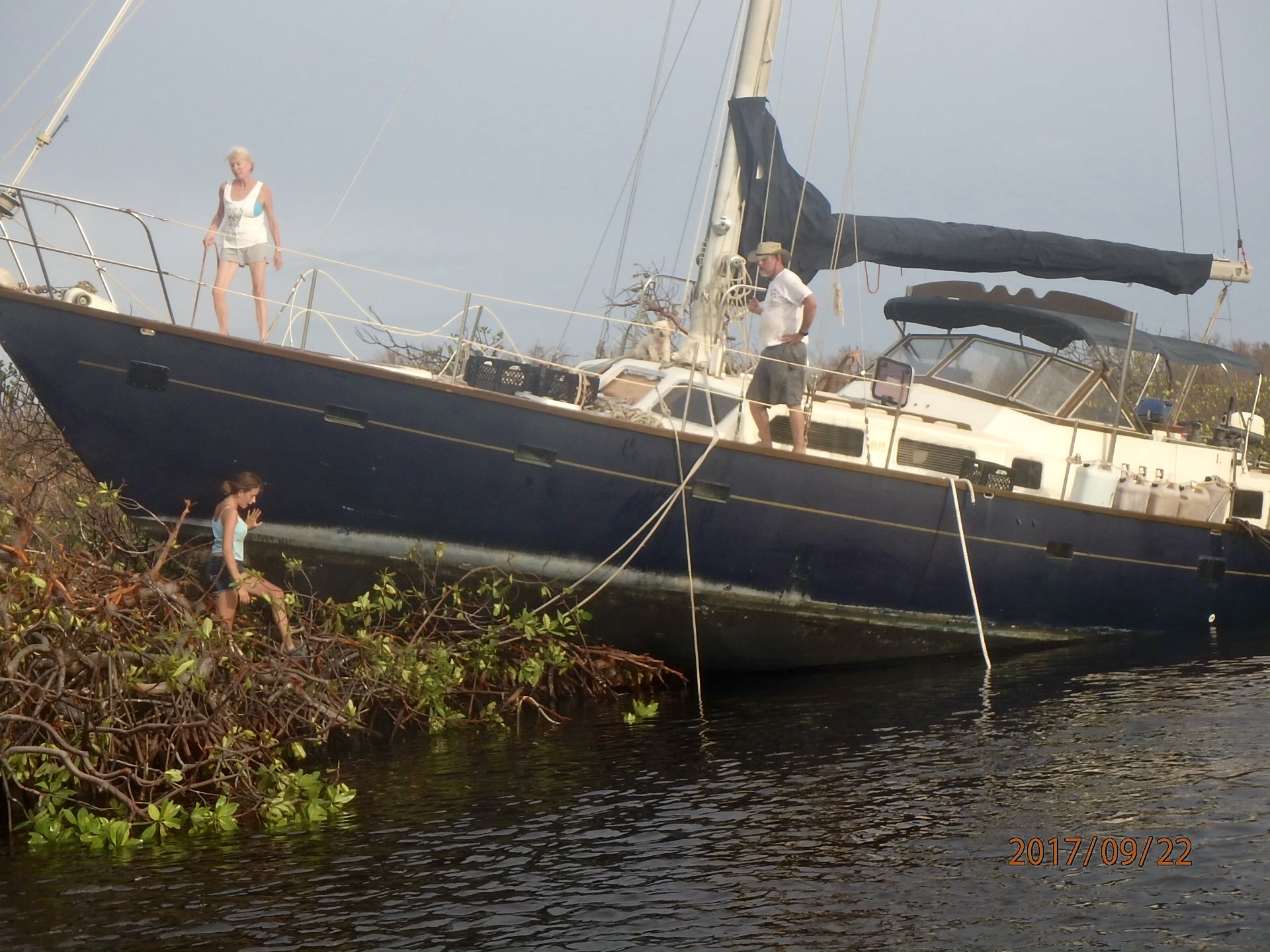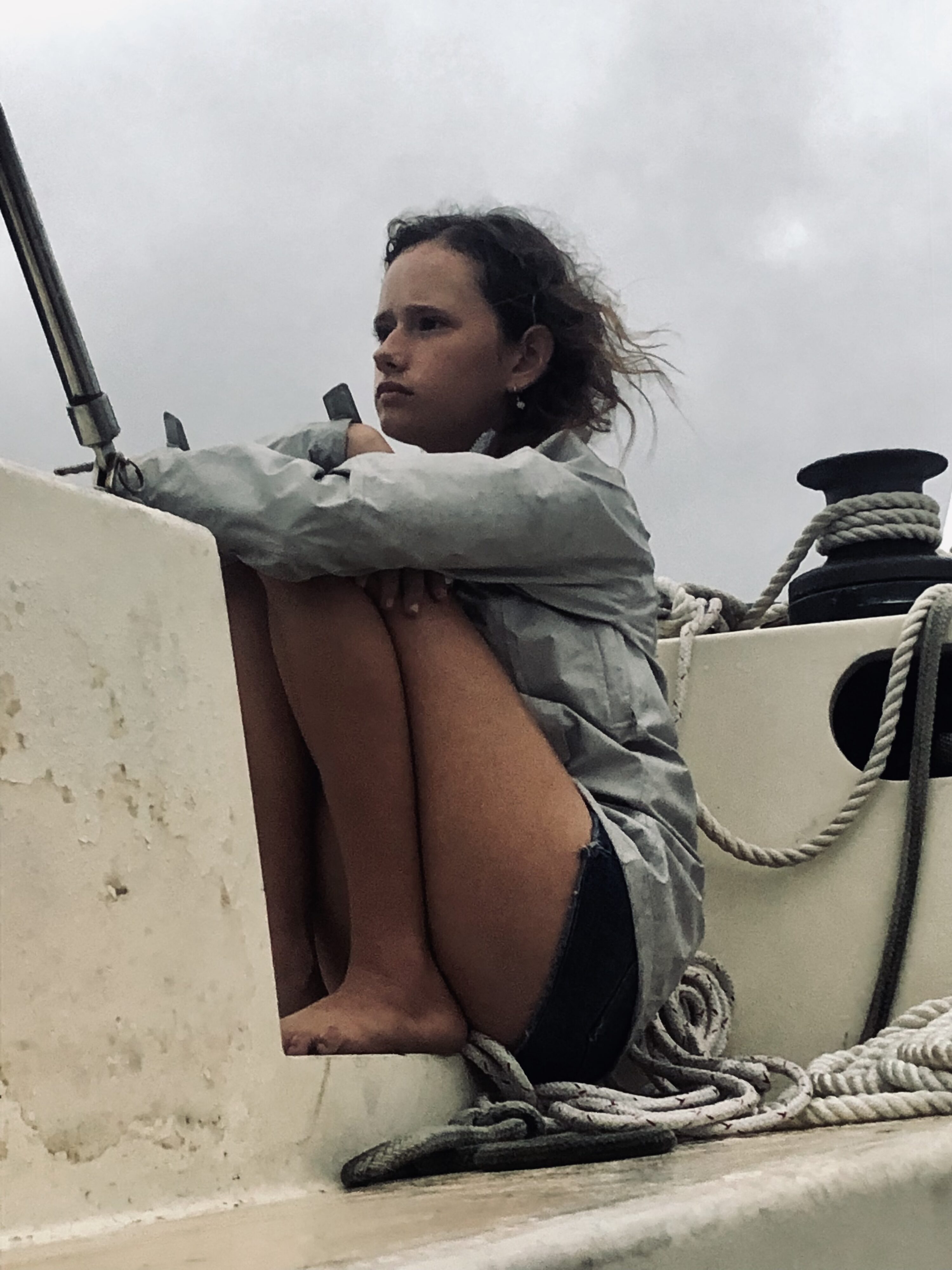
Courtesy of Katie Russell, September 22, 2017.

Courtesy of Katie Russell, September 22, 2017.
When the reports said that another hurricane was building in the Atlantic it was no surprise. My family checked the weather every morning with a practiced wariness built on decades of Caribbean hurricane seasons. When the predicted track directed it over our little mooring in St. Thomas, United States Virgin Islands (U.S.V.I.), we prepared as we always did.
Not long after, there was talk of developing a new classification to describe the monster storm – category 6. The alarms sounded when Hurricane Irma was announced to be the strongest hurricane in recorded Atlantic history.
Despite those that would call us crazy, there was never any question as to whether we would leave our sailboat. We had lived aboard our 48-foot monohull, Verity, since I was an infant. So, we left St. Thomas for the secluded mangrove lagoons of Vieques, just 70 miles east of Puerto Rico. The strong mangrove roots anchoring us into place, we nestled ourselves back into the winding estuaries and waited out the storm.
Perched on the bow as we sailed back into St. Thomas, I saw the desolation that was my beautiful island and my heart crumpled. The bright colors of a tropical paradise were gone. Every plant was dead, stripped of green from the wind and salt spray. Houses and their contents surged down hillsides, tumbling into the water. The shoreline was littered with broken and bleeding boats, the water cloudy and slick with dirt and chemical runoff. Gunshots rang out across the island from looting. The infrastructure along the coast was all but razed to the ground. It looked like a bomb had dropped.
As our shell-shocked community attempted to make sense of the damage, we struggled to obtain the basic necessities. People crawled out of mangled homes into the blinding destruction to face the new reality of surviving in a disaster zone. The roads were impassable, electricity a distant dream. Puerto Rico and St. Croix were sending aid, oblivious to the disaster brewing on Irma’s heels.

Less than two weeks later, my family was forced to retreat again to Vieques for category 5 Hurricane Maria. Our little estuary saw the eyewall of the storm shortly after it pummeled St. Croix and before it decimated Puerto Rico.
The early morning hours of Sept. 20, 2017, will forever haunt me. The screeching howl of the 175mph wind as though it was a nightmare given life; the full-body jolt of the lines that held us in place snapping one by one; the window being sucked right out of its frame; rain water gushing in, flooding the floor boards; the printer sailing through the air across the salon, smashing into pieces a foot from my head; the screeching of the mangrove branches digging into the hull.
The next morning revealed the damage: all of our windward side lines had snapped or uprooted the massive mangroves from the earth. Verity had been picked up by the storm surge and deposited on top of the mangroves at a 45° angle. We lived like that for three days.
In the end, we were absurdly lucky. Our neighbors put together their collective expertise and hauled our 23-ton boat back into the water. I sailed away from Vieques immensely grateful for our lives and our home.
During the catastrophe of what is colloquially known as IrMaria, we lost all communication. We did not know where the storm was, how strong it was, or how fast it was moving. In the words of Jay Titlow, senior meteorologist at Weatherflow Inc., “who cares about all of our data and observations if you can’t get that information out to the people who need it”; and we needed it.
Local historian Gabrielle Querrard describes the sinking dread while listening to the radio as Maria slammed St. Croix. “Right when the winds started to pick up the entire radio line went dead and all you could hear was this white noise… after that, all of the Cruzans went silent and you could not get any information in or out of St. Croix”. Brought to tears with the memory, she describes the grief that she felt for our sister island as they went through in silence what she had experienced 12 days before.
When you are living in so much fear, so much uncertainty and such a lack of control, the psychological necessity for communication and information is fundamental. With the wind shrieking and being unable to see a foot in front of you, the radio was all we had tying us to the rest of civilization, to reality.

In the aftermath, amateur ham radio operators were the only ones capable of transmitting. They relayed messages to panicked loved ones in the states, coordinated evacuations and relief efforts, and connected us with external aid. Neither the National Guard, Red Cross nor FEMA could get to us. They were the only safety net we had for weeks before communication was restored. The civilian ham radio operators of the Virgin Islands and Puerto Rico saved lives during Irma and Maria.
Almost all the emergency warning systems in place failed at some point during the storms. All that could be relied on was the Amateur Radio Emergency Service (ARES). The herculean efforts of the ARES operators have recently earned them the official designation as the first Auxiliary Communications Unit under the U.S.V.I. Territorial Emergency Management Agency, solidifying and formalizing their role in emergency response in the V.I.
The ham radio community mobilized in the years following the storms, offering classes and licensing exams. The storms made the fragility of our communication systems front and center for all of us, sparking a demand for licensing. Prior to their classes, there was virtually no way to get licensed in the Virgin Islands.

In the spring of 2019, I took the first ham radio class offered in St. Thomas and passed both my technical and general exams. Every Monday at 8pm I would check in to the ARES net with my individual callsign, NP2RO. Without fail, every week we convened to ensure that our network was ready for action, and every week there were new voices. Simultaneously, I founded my high school’s ham radio club – NP2AS – to educate my peers of ham radio’s vital role. Over time, more of our friends, family and neighbors pledged to protect their community in the face of disaster.
The grief and fear that I experienced during Irma and Maria changed my life. The PTSD from the storms and the anxiety that has plagued every hurricane season since then is difficult to put into words. The reality is that climate change will make storms like Irma and Maria more common, and our community needs to prepare. That is why I am committed to finding ways to communicate the urgency and opportunities to improve our situation both at home and abroad. It is why I am dedicated to building resiliency and raising awareness to protect the island, and the planet, that I call home.